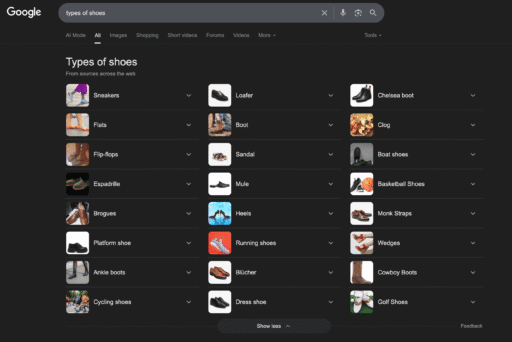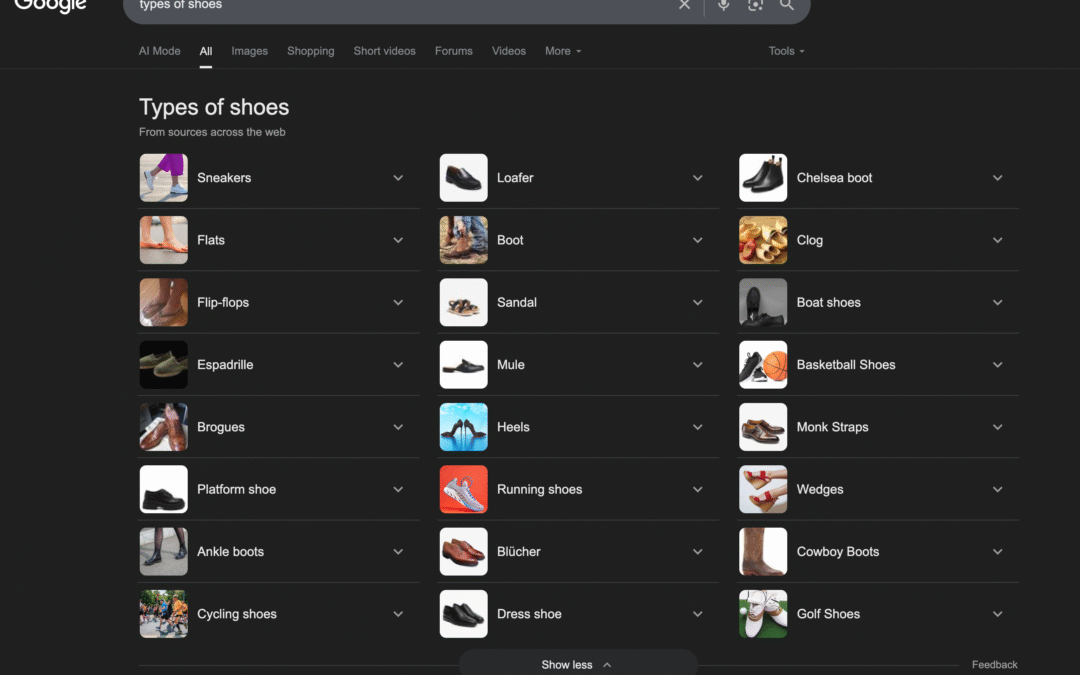If you’ve ever wondered about the relationship between keywords, long-tail keywords, and entities in SEO, you’re not alone. During a recent live stream, I had the opportunity to break down these concepts using a real-world example that perfectly illustrates how these elements work together in modern search optimization.
Understanding Entities in SEO
Let’s start with the big picture. When we talk about entities in SEO, we’re referring to the fundamental “things” that search engines understand – people, places, objects, and concepts. But it goes deeper than the traditional grammar definition.
Take the example I used in the video: a Runner’s World article titled “12 Best Running Shoes of 2025”. This seemingly simple title contains multiple layers of entities and keyword structures that are worth unpacking.
The Entity Hierarchy
Think of entities like a tree structure, starting broad and getting more specific:
- Broad entity: Shoes
- More specific entity: Running shoes
- Sub-entities: Boot, sandal, mule, heels, sneakers, flats, etc.
When you search for “types of shoes” in Google (as shown in my demonstration), you’ll see this entity hierarchy in action. Google understands that shoes is the umbrella term, and all these specific shoe types are related entities underneath it.
Breaking Down the Example: “12 Best Running Shoes of 2025”
This phrase is a perfect case study because it demonstrates several SEO concepts working together:
The Main Entity
The core entity here is “running shoes” – this is what the content is fundamentally about.
The Long-Tail Keyword
“12 best running shoes of 2025” is a long-tail keyword. It’s specific, targeted, and likely to have lower competition than just “running shoes” while attracting users with high purchase intent.
Entity Modifiers
The phrase contains two important modifiers:
- Numerical entity: “12” – This gives the content structure and sets expectations
- Temporal entity: “2025” – This is time-based, making the content current and relevant
These modifiers don’t change the main entity (running shoes), but they provide important context that helps search engines and users understand exactly what the content offers.
The Missed Opportunity: Turning Lists into Pillar Pages
Here’s where it gets interesting from a content strategy perspective. The Runner’s World article I analyzed is essentially a list post – “12 best” something. While this can rank well, it’s missing a huge opportunity to become a true pillar page.
What They Could Do Better
Instead of just listing 12 running shoes with brief descriptions, they could:
- Create detailed, individual review pages for each shoe
- Include real testing data (running in different weather, with different socks, etc.)
- Link internally from the main “12 best” page to these detailed reviews
- Build topic clusters around running shoe subtopics
This approach would transform a simple list into a comprehensive content hub that could dominate search results for running shoe-related queries.
Practical Application: Using Entity Research for Content Strategy
When planning your content strategy, start by identifying your main entities, then work outward:
- Identify your core entity (e.g., “running shoes”)
- Research related entities using tools like Google’s “types of” search
- Find temporal and numerical modifiers that make sense for your audience
- Plan content clusters around these entity relationships
- Create internal linking strategies that reinforce these relationships
The “Types of” Search Strategy

One of the most underutilized research methods is the “types of” search. Simply search for “types of [your main keyword]” and Google will often show you related entities that you can target with separate content pieces.
Beyond Traditional Keywords: Understanding Search Intent
Modern SEO isn’t just about finding keywords – it’s about understanding the relationships between entities and the intent behind searches. When someone searches for “12 best running shoes of 2025,” they’re not just looking for a keyword match. They want:
- Current recommendations (2025)
- A manageable number of options (12)
- Quality curation (best)
- Specific product type (running shoes)
Your content strategy should address all these intent signals, not just include the keywords.
Key Takeaways for Your SEO Strategy
- Think in entities, not just keywords – Understand what your content is fundamentally about
- Use modifiers strategically – Temporal and numerical modifiers can reduce competition while increasing specificity
- Build content clusters – Don’t just create standalone pages; build interconnected content hubs
- Research entity relationships – Use Google’s “types of” searches to discover related topics
- Focus on search intent – Understand why people are searching, not just what they’re searching for
Tools and Techniques
During the stream, I demonstrated a bookmarklet tool I created for finding long-tail keyword opportunities. While the specific tool wasn’t the focus, the principle remains important: always be looking for ways to discover the language your audience uses and the relationships between the topics they care about.
The combination of entity research, long-tail keyword targeting, and strategic internal linking creates a powerful SEO approach that goes beyond traditional keyword stuffing and builds genuine topical authority.
Want to dive deeper into these concepts? Join our SEO Training Camp community on Facebook where we regularly discuss advanced SEO strategies and share tools like the bookmarklet demonstrated in this video.
What’s your experience with entity-based SEO? Have you tried building content clusters around related entities? Share your thoughts in the comments below!

